牛津译林版高中英语选修八春高二英语unit3periodfivetask
Module8unit3languagepoingts(译林牛津版高二英语选修八教案教学设计)
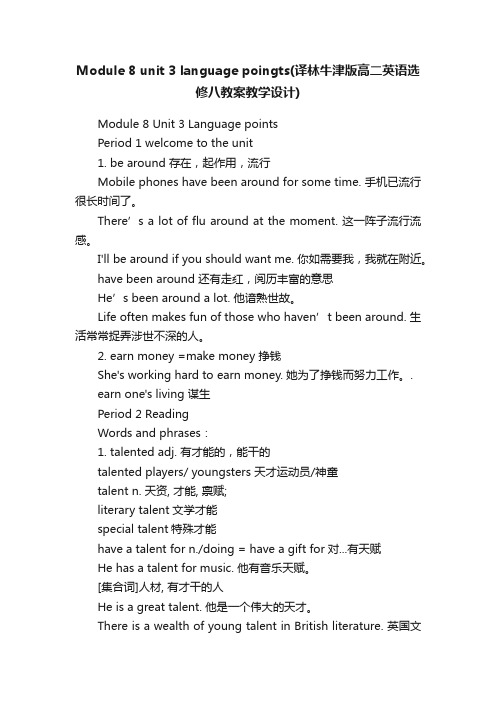
Module 8 unit 3 language poingts(译林牛津版高二英语选修八教案教学设计)Module 8 Unit 3 Language pointsPeriod 1 welcome to the unit1. be around 存在,起作用,流行Mobile phones have been around for some time. 手机已流行很长时间了。
There’s a lot of flu around at the moment. 这一阵子流行流感。
I'll be around if you should want me. 你如需要我,我就在附近。
have been around 还有走红,阅历丰富的意思He’s been around a lot. 他谙熟世故。
Life often makes fun of those who haven’t been around. 生活常常捉弄涉世不深的人。
2. earn money =make money 挣钱She's working hard to earn money. 她为了挣钱而努力工作。
.earn one's living 谋生Period 2 ReadingWords and phrases:1. talented adj. 有才能的,能干的talented players/ youngsters 天才运动员/神童talent n. 天资, 才能, 禀赋;literary talent文学才能special talent特殊才能have a talent for n./doing = have a gift for对...有天赋He has a talent for music. 他有音乐天赋。
[集合词]人材, 有才干的人He is a great talent. 他是一个伟大的天才。
There is a wealth of young talent in British literature. 英国文学年轻一代人才辈出。
高中英语译林版选修8教学案:Unit 3 Section 5
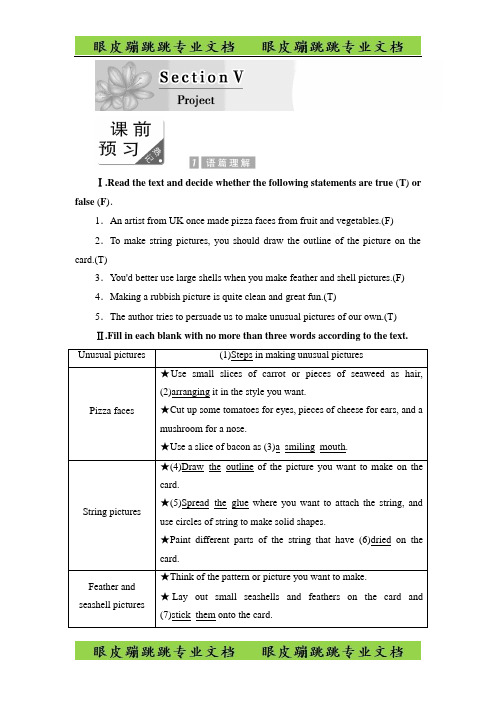
Ⅰ.Read the text and decide whether the following statements are true (T) or false (F).1.An artist from UK once made pizza faces from fruit and vegetables.(F)2.To make string pictures, you should draw the outline of the picture on the card.(T)3.You'd better use large shells when you make feather and shell pictures.(F)4.Making a rubbish picture is quite clean and great fun.(T)5.The author tries to persuade us to make unusual pictures of our own.(T)Ⅱ.Fill in each blank with no more than three words according to the text. Unusual pictures (1)Steps in making unusual picturesPizza faces ★Use small slices of carrot or pieces of seaweed as hair, (2)arranging it in the style you want.★Cut up some tomatoes for eyes, pieces of cheese for ears, and a mushroom for a nose.★Use a slice of bacon as (3)a_smiling_mouth.String pictures ★(4)Draw_the_outline of the picture you want to make on the card.★(5)Spread_the_glue where you want to attach the string, and use circles of string to make solid shapes.★Paint different parts of the string that have (6)dried on the card.Feather and seashell pictures ★Think of the pattern or picture you want to make.★Lay out small seashells and feathers on the card and (7)stick_them onto the card.Rubbish pictures★Stick the rubbish onto the card tightly.★Spray paint over the different sections of the picture(8)when/once the rubbish is stuck on.Rubbishprints★Dip one end of a tin into paint and draw circles on a card.★Use old cloth pieces as brushes or(9)wrinkle the cloth togetherto form an interesting pattern.★Cut shapes out of other rubbish, dip them into the paint and(10)press_them on the card.Ⅰ.单词拼写1.She dipped (伸入,浸入) her finger into the water to see if it was hot.2.Cut the pork into thin slices (薄片), and then put them into the soup.3.Her husband is a chef (厨师长) in a big restaurant.4.Every weekend children go there to pick up seashells (海贝壳).5.I bought some eggplants (茄子) for supper.6.He was found asleep on a pillow (枕头) of leaves and moss.Ⅱ.拓展词汇1.disgusting adj.令人不快的,令人厌恶的,令人愤慨的→disgust n.反感,厌恶v.(使)反感,厌恶→disgusted adj.厌恶的,反感的2.spray v t.喷,喷洒,向……喷洒n.喷剂;浪花→sprayer n.喷雾者,喷雾器3.wrinkle v t.&v i.(使)起皱纹n.皱纹;皱褶;皱痕→wrinkled adj.有皱纹的,显出皱纹的[巧记单词]派生词sprayer →spray+-erwrinkled →wrinkle+-dⅢ.补全短语1.carry out执行2.be made out_of由……制成3.cut up 切碎4.lay out展开,铺开;布置,设计5.cut something out (of something)剪出,剪下6.have a go (at) 试一试7.try out试验1.[教材原句]When you have made the face, you can take a photo of it, so that you can keep your unusual picture forever.做好这张脸之后,你可以为之拍一张照片,以便你能永久地保存这张不寻常的照片。
牛津译林版高中英语选修八《Unit3 The world of colors and light》Task 教案 3
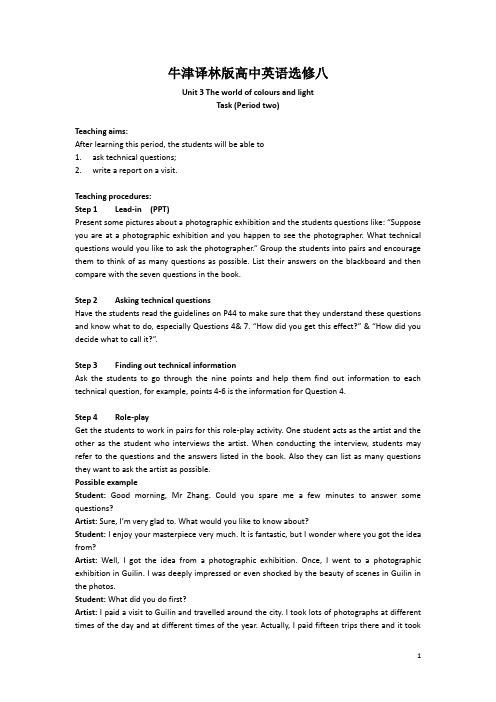
牛津译林版高中英语选修八Unit 3 The world of colours and lightTask (Period two)Teaching aims:After learning this period, the students will be able to1.ask technical questions;2.write a report on a visit.Teaching procedures:Step 1 Lead-in (PPT)Present some pictures about a photographic exhibition and the students questions like: “Suppose you are at a photographic exhibition and you happen to see the photographer. What technical questions would you like to as k the photographer.” Group the students into pairs and encourage them to think of as many questions as possible. List their answers on the blackboard and then compare with the seven questions in the book.Step 2 Asking technical questionsHave the students read the guidelines on P44 to make sure that they understand these questions and know what to do, especially Questions 4& 7. “How did you get this effect?” & “How did you decide what to call it?”.Step 3 Finding out technical informationAsk the students to go through the nine points and help them find out information to each technical question, for example, points 4-6 is the information for Question 4.Step 4 Role-playGet the students to work in pairs for this role-play activity. One student acts as the artist and the other as the student who interviews the artist. When conducting the interview, students may refer to the questions and the answers listed in the book. Also they can list as many questions they want to ask the artist as possible.Possible exampleStudent:Good morning, Mr Zhang. Could you spare me a few minutes to answer some questions?Artist:Sure, I’m very glad to. What would you like to know about?Student: I enjoy your masterpiece very much. It is fantastic, but I wonder where you got the idea from?Artist: Well, I got the idea from a photographic exhibition. Once, I went to a photographic exhibition in Guilin. I was deeply impressed or even shocked by the beauty of scenes in Guilin in the photos.Student: What did you do first?Artist: I paid a visit to Guilin and travelled around the city. I took lots of photographs at different times of the day and at different times of the year. Actually, I paid fifteen trips there and it tookme over a year to cover the city.Student: What did you do next?Artist: I grouped the photographs, including the most popular views of the river, according to different areas in Guilin.Student: How did you get this effect?Artist: I had to decide on how big to make the first painting and what to put in the other paintings in the collection. I also used some material to press a print into it. Effect was made with a knife and fork. As a result, the marks made by the blade could be seen, just as you see in the paintings.Student: So how long did it take you to finish your work?Artist: It took me a year to take the photographs and two more years to finish all the paintings. Student:Wow! That’s such a long time. Then how did you decide what to call it?Artist: In my opinion, no one can ever see all of Guilin, so I decided to call the collection of painting Glance of Guilin. Besides, painting Guilin Heights was named because it shows the hills around Guilin and because of its size.Student: What do you think of your masterpiece?Artist: I’m quite proud o f the piece Guilin Heights because it is unique.Student: Thank you very much, Mr Zhang. This helps me a lot in understanding your art. Artist: Glad you enjoy it.Step 5 Writing a report on a visit1. Groups the students to discuss the structure of a report to an exhibition with informationgathered in Steps 1& 2. And make sure they know what each point means and what should be included in a report.2. Have the students work in groups to write an outline of the report. Each group member is responsible for a particular section.Step 6 Write a report1. First, ask the students to read the instructions in this section and help them review the information they’ve gathered in Steps 1&2. Then ask them to work in groups to complete the writing, when writing, they may refer to the structure of the report in Skills building3. After about 10 minutes, get each group to give presentation of their drafts.Possible exampleReport on Art Club visit to Glance of GuilinIntroductionPlace of visit: City art GalleryDate of visit: 29th MayWhat was seen: an exhibition by Zhang LinghongThe exhibition1. The collection: 12 paintings, painted between 2003 and 20042. The masterpiece:Guilin Heights, over 3m tall, focusing on several caves, painted in a unique way.The artistBorn in Hangzhou in 1961, admitted to Beijing School of Art in 1983, set up a studio in Hangzhouafter graduation, studied in the USA in the 1990s, presented his paintings in GuilinConclusionfantastic and impressive, painted at different angles, cannot be missed2. Ask the students to organize the above points and rewrite it into a paragraph, helping them further understand and grasp how to write a report on a visit. If possible, ask the students to polish their writings in groups.A possible version:On May 29th, we paid a visit to City Art Gallery to see an exhibition by Zhang Lihong. The exhibition showed 12 paintings which were painted between 2003 and 2004. Of these works the one named Guilin Heights deeply impressed us. It is a painting that was painted in a unique way, which is over three meters tall and focuses on describing several caves.When it comes to the painting Guilin Heights, we will think of its artist Zhang Linghong. He was born in Hangzhou in 1961. At the age of 22, he was admitted to Beijing School of Art. After his graduation, he set up a studio in Hangzhou and continued his study in the USA in the 1990s. There is no denying that the paintings showed in City Art Gallery are fantastic and impressive and they are painted at different angles and can not be missed.。
译林牛津版高中英语选修8课件Unit3 Task课件
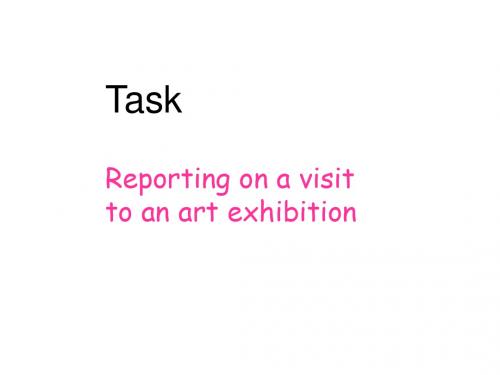
gallery, a museum or an exhibition?
2. Where and when did you go?
3. Why did you go there?
4. Did you see someone like the organizer of the exhibition, the artisit or the photographer there?
Task
Reporting on a visit to an art exhibition
Skill building 1: listening to instructions to report on a visit?
Discussion 1.Have you ever visited an art
ቤተ መጻሕፍቲ ባይዱ 6. Find out about his_m_a_s_t_e_r_p_ie_c_e_
7. Find out why the painter chose the name for the exhibition.
Part C Listen to the tap and fill in the missing information
Part A
Things to include in my report 1. What place I visited 2. __w__h_e_n___I went to there 3. __w_h_a_t____I went to see
牛津译林版高中英语选修八高二下学期模块八unit3基础知识归纳
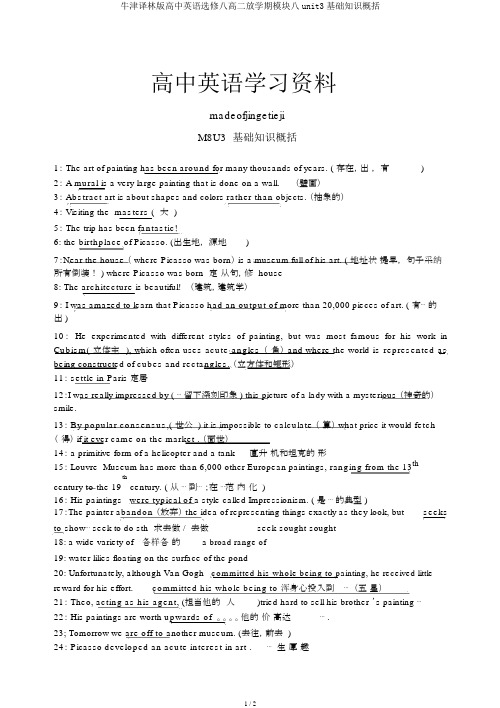
高中英语学习资料madeofjingetiejiM8U3 基础知识概括1: The art of painting has been around for many thousands of years. ( 存在,出,有)2: A mural is a very large painting that is done on a wall.(壁画)3:Abstract art is about shapes and colors rather than objects. (抽象的)4: Visiting the masters (大 )5: The trip has been fantastic!6: the birthplace of Picasso. (出生地,源地)7:Near the house ( where Picasso was born) is a museum full of his art. ( 地址状提早,句子采纳所有倒装! ) where Picasso was born 定从句,修 house8: The architecture is beautiful!(建筑,建筑学)9: I was amazed to learn that Picasso had an output of more than 20,000 pieces of art. ( 有⋯的出 )10:He experimented with different styles of painting, but was most famous for his work in Cubism( 立体主 ), which often uses acute angles (角)and where the world is represented as being constructed of cubes and rectangles.(立方体和矩形)11:settle in Paris 定居12:I was really impressed by ( ⋯留下深刻印象 ) this picture of a lady with a mysterious (神奇的)smile.13:By popular consensus,(世公) it is impossible to calculate(算) what price it would fetch (得) if it ever came on the market . (面世)14: a primitive form of a helicopter and a tank直升机和坦克的形15: Louvre Museum has more than 6,000 other European paintings, ranging from the 13ththcentury. ( 从⋯到⋯;在⋯范内化 )century to the 1916: His paintings were typical of a style called Impressionism. (是⋯的典型)17:The painter abandon(放弃)t he idea of representing things exactly as they look, but seeks to show⋯seek to do sth求去做/去做seek-sought-sought18: a wide variety of各样各的 a broad range of19: water lilies floating on the surface of the pond20: Unfortunately, although Van Gogh committed his whole being to painting, he received little reward for his mitted his whole being to 浑身心投入到⋯(五星)21: Theo, acting as his agent, (担当他的人)tried hard to sell his brother ’s painting ⋯22: His paintings are worth upwards of。
译林英语选修8Unit3Task PPT课件

• _w_h_e_r_e_ the visit took place
5 wh • _w_h_e_n__ the visit took place • _w__h_y__ the visit took place • _w__h_a_t_ you saw on the visit
• __w_h_o__you met on the visit
Step 1: taking notes to report on a visit
Read the notes in Part A, Now listen to Part A and complete the notes on page 42.
Things to include in my report 1. what place I visited 2. w__h_e_n_I went to there 3. w__h_a_t_I went to see 4. r_e_a_s_o_n_ for the trip • say something about the_ex_h__ib_i_ti_o_n • describe some of the p__a_in_t_in__g_s
译林英语选修8Unit3Task PPT课件
单元写作——参观报告
The structure of a report on a visit
general introduction main body
where when with whom what you saw what you felt
牛津译林版高中英语选修八《Unit3 The world of colors and light》Task 教案 2
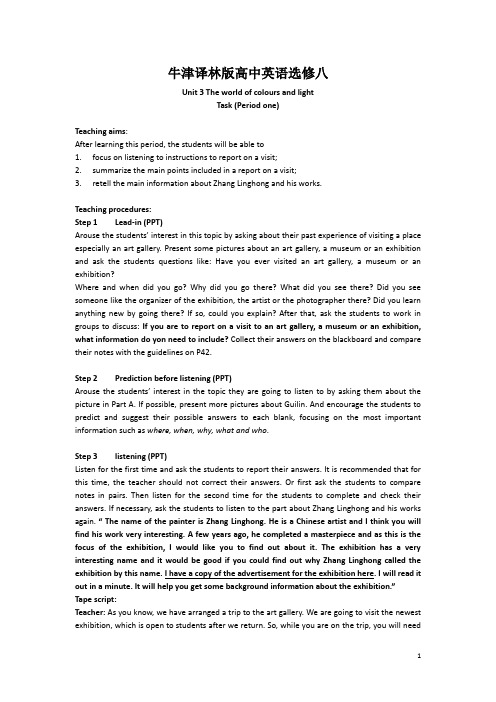
牛津译林版高中英语选修八Unit 3 The world of colours and lightTask (Period one)Teaching aims:After learning this period, the students will be able to1.focus on listening to instructions to report on a visit;2.summarize the main points included in a report on a visit;3.retell the main information about Zhang Linghong and his works.Teaching procedures:Step 1 Lead-in (PPT)Arouse the students’ interest in this topic by asking about their past experience of visit ing a place especially an art gallery. Present some pictures about an art gallery, a museum or an exhibition and ask the students questions like: Have you ever visited an art gallery, a museum or an exhibition?Where and when did you go? Why did you go there? What did you see there? Did you see someone like the organizer of the exhibition, the artist or the photographer there? Did you learn anything new by going there? If so, could you explain? After that, ask the students to work in groups to discuss: If you are to report on a visit to an art gallery, a museum or an exhibition, what information do yon need to include? Collect their answers on the blackboard and compare their notes with the guidelines on P42.Step 2 Prediction before listening (PPT)Ar ouse the students’ interest in the topic they are going to listen to by asking them about the picture in Part A. If possible, present more pictures about Guilin. And encourage the students to predict and suggest their possible answers to each blank, focusing on the most important information such as where, when, why, what and who.Step 3 listening (PPT)Listen for the first time and ask the students to report their answers. It is recommended that for this time, the teacher should not correct their answers. Or first ask the students to compare notes in pairs. Then listen for the second time for the students to complete and check their answers. If necessary, ask the students to listen to the part about Zhang Linghong and his works again. “ The name of the painter is Zhang Linghong. He is a Chinese artist and I think you will find his work very interesting. A few years ago, he completed a masterpiece and as this is the focus of the exhibition, I would like you to find out about it. The exhibition has a very interesting name and it would be good if you could find out why Zhang Linghong called the exhibition by this name. I have a copy of the advertisement for the exhibition here. I will read it out in a minute. It will help you get some background information about the exhibition.”Tape script:Teacher: As you know, we have arranged a trip to the art gallery. We are going to visit the newest exhibition, which is open to students after we return. So, while you are on the trip, you will needto collect some information. There are certain things you will need to include in the report. Obviously, you will need to say what place you visited and when you went. You will also need to explain what you went to see and the reason for the trip. That means you will need to describe some of the paintings. You should also say whether you liked them or not. You will need to give some details about the painter and his life as well. This will include where he grew up and how he became interested in painting. You also need to find out where he has studied. Did he study overseas? The name of the painter is Zhang Linghong. He is a Chinese artist and I think you will find his work very interesting. A few years ago, he completed a masterpiece and as this is the focus of the exhibition, I would like you to find out why Zhang Linghong called the exhibition by this name. I have a copy of the advertisement for the exhibition here. I will read it out in a minute. It will help you get some background information about the exhibition. Now, does anyone have any questions?Student: Can I just check what we should include in our report?Teacher:Yes, of course. Why don’t you tell me what you think should be included?Student: Well, I think you said to include the place of the visit, and the date. Explain what we went to see and the reason. We should describe some of the paintings and say what we thought about them. We need to give some details about the painter and his life, like where he grew up and how he became interested in painting. We should also include where he studied. Finally, we need to find out about his masterpiece and why he chose the name of the exhibition. Is that right?Teacher: Yes, well done. Of course, also include anything else you find out that will make your report more interesting!Step 4 Listening for Part B (PPT)Help the students to collect information about Zhang Linghong and his works from the listening material in Part A. And ask the students what advertisement for the exhibition the art teacher has(the underlined sentence). Then get the students to study the advertisement for the exhibition in Part B on P43. Firstly, listen and check answers. Secondly, listen and ask the students to retell what they’ve heard.Tape script:Teacher : The ad says that at the City Art Gallery, there is an exhibition called Glance of Guilin by the artist Zhang Linghong. The exhibition runs from the twenty-second of May until the twenty-ninth of May. There is a special price of five yuan on Student Day, which is on the twenty-ninth of May. The ad also says Zhang Linghong has been painting for twenty years and this is an exhibition of his recent work in Guilin, Guangxi Province. His paintings show many beautiful views of the Li River and the surrounding hills, and they are presented in a unique way.Step 5 Reading (PPT)Read Part C and underline any useful information that is not mentioned in the advertisement in Part B.✧Zhang Linghong was born in Hangzhou in 1961.✧In 1983, he was admitted to the Beijing School of art. His early works were traditionalChinese style watercolours that reflected the scenery of eastern China.✧He later set up a studio in his hometown of Hangzhou.✧In the 1990s, he won a scholarship to study in the USA.✧Glance of Guilin is a collection of 12 paintings that were painted between 2003 and 2004.✧The first painting in the Glance of Guilin collection has been called a masterpiece. It is calledGuilin Heights and it is over three metres tall.Language points: (PPT)(1)… they got a real bargain.a good/real bargain: thing, usu valuable, bought at a very low price.e.g. a. I bought a coat for only 50p at the sales; it was a real bargain.b. Sometimes, you pick up wonderful bargains in these markets.(2) In 1983, he was admitted to the Beijing School of Art.Read and figure out the different meanings of“admit” in the following sentences.a. This ticket will admit three to the concert.b. Sixty new boys and girls will be admitted to this school.c. I admit breaking the window.d. The theatre only admits 1,000 persons.Step 6 Summarizing and reportingIf possible, allow the students enough time to go over and summarize the things to include in a report on a visit as well as the information about Zhang Linghong and his exhibition for the purpose of writing in Skill building 3—writing a report on a visit.。
(译林版)英语选修8课件:Unit 3 Period Five Task
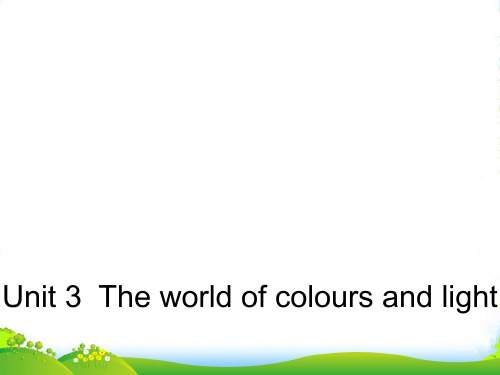
Possible example
Student: Good morning, Mr Zhang. Could you spare me a few minutes to answer some questions? Artist: Sure, I’m very glad to. What would you lSiktuedteonkt:nIowenajobyouyto?ur masterpiece very much. It is fantastic, but I wonder where you got the idea from? AStrutdisetn: t…: What did you do first? Artist: … Student: What did you do next? Artist: …
about the artist and his work.
Artist Time 1961 D_u_r_in_g___ the 1970s
Zhang and 1980 L_i_n_g_h_ong
1983
1990s
beห้องสมุดไป่ตู้ween 2003 and 2004
Event b__o_rn__i_n_H__angzhou
6. Find out about his_m__a_st_e_r_p_i_ec_e_ 7. Find out why the painter chose the name for the exhibition.
22nd
29
5
20
Li River
hills
Read the brochure and get more information
Unit 3 The world of colours and light
牛津译林版高中英语选修八Unit3TheworldofcoloursandlightPeriodFo
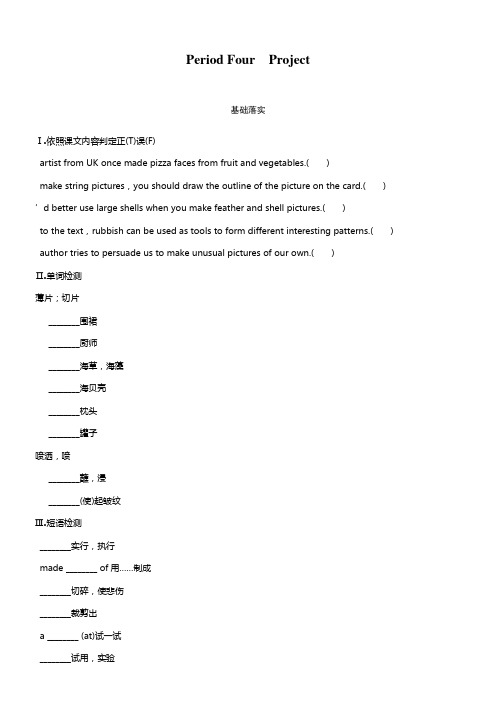
Period Four Project基础落实Ⅰ.依照课文内容判定正(T)误(F)artist from UK once made pizza faces from fruit and vegetables.( )make string pictures,you should draw the outline of the picture on the card.( )’d better use large shells when you make feather and shell pictures.( )to the text,rubbish can be used as tools to form different interesting patterns.( ) author tries to persuade us to make unusual pictures of our own.( )Ⅱ.单词检测薄片;切片________围裙________厨师________海草,海藻________海贝壳________枕头________罐子喷洒,喷________蘸,浸________(使)起皱纹Ⅲ.短语检测________实行,执行made ________ of用……制成________切碎,使悲伤________裁剪出a ________ (at)试一试________试用,实验Ⅳ.选词填空cut up,have fun,be made out of,lay out,have a go,set up________ a company which/that only sold computers.________ a lot of ________ at Sarah’s party.bridge with a history of several hundred years ____________________ stones.gardens were ____________ with lawns and flower beds.work is a real ’s ____________.piece of cloth will __________ into three suits.Ⅴ.单项填空matter what you say,I shall ________ my opinion.out upon tousually do the washingup and leave the cooking to my wife,________ she’s a better cook than me.thoughcaseson is clever enough to work out the problem ________.his own his ownhis own his ownwas only when I reread his poems recently ________ I began to appreciate their beauty.museum will open in the spring with an exhibition and a viewing platform ________ visitors can watch the big glasshouses being built.(2013·浙江,13)6.—My daughter broke my cup,which you gave me.—Oh,it’s a pity,but I wish you hadn’t ________ her.a go at a try ona go for a try atwaitress,________ us ________ ice cream,is said to have been to university.;with ;with;for ;withis a is ________ to smoke in the yard.disgust9.—Look!What do you think of my new dress?—Well,you look nice in it,but it seems a bit loose,you’d better had it ________.down offup out10.—Her father is very rich.—________She wouldn’t accept his help even if it were offered.for? what?doubt. wonder.能力提升阅读明白得Among the seven wonders of the ancient architectural (建筑方面的) world,the pyramids in Egypt are the only ones still standing.For 1,000 years,they were the tallest buildings in the with prehistoric technology,they were an architectural mystery,as strange as the Sphinx (大狮身人面像).No one really knows how they were first historical record,by the Greek writer Heroditus,came 2,000 years hard facts,there have been many theories.Hollywood has mostly followed the examples from the Greek record:100,000 slaves worked hard for 20 believe a very large slope snaked around the American recently put forward the theory that kites could have lifted the 2ton stones.Now Houdin,a French architect,says that after studying the pyramids for eight years,he has solved the mystery with the help of 3D computer animation (三维动画).He believes the pyramids were built from the inside out through an internal slope that goes around a central point.“This iscompletely before me thought that the pyramids were built from the outside,and only from the outside,”he said.Scholars of ancient Egypt are interested.“It’s a theory which sounds of ancient Egypt agree it ought to be tested,and it doesn’t cause damage,so I wouldn’t be surprised that within a year,we have the final answer,”said Bob Brier,a scholar at Long Island University.If that is the case,we’ll know the truth about the pyramids in_the_blink_of_an_eye,considering this mystery has lasted for nearly 5,000 years.to the passage,how many ancient wonders in architecture have disappeared so far?. .. .are many theories of how the pyramids were built because ________.have different professional knowledgeresearch the pyramids from different aspectsare no reliable records of how the pyramids were builtare many stories about how the pyramids were builtFrench architect Houdin put forward his theory with the help of ________.expertstechnologyscholars of ancient Egypthistorical recordunderlined phrase “in the blink of an eye” in the last paragraph probably means “________”.a short timethe distant futureby using your own eyesthe state of uncertainty答案基础落实Ⅰ.Ⅱ.;apron;chef;seaweed;seashell;pillow;tin ;dip;wrinkle Ⅲ.Ⅳ. up ;fun made out of out a go upⅤ.能力提升。
牛津译林版高中英语选修八Unit3TheworldofcoloursandlightPeriodTh
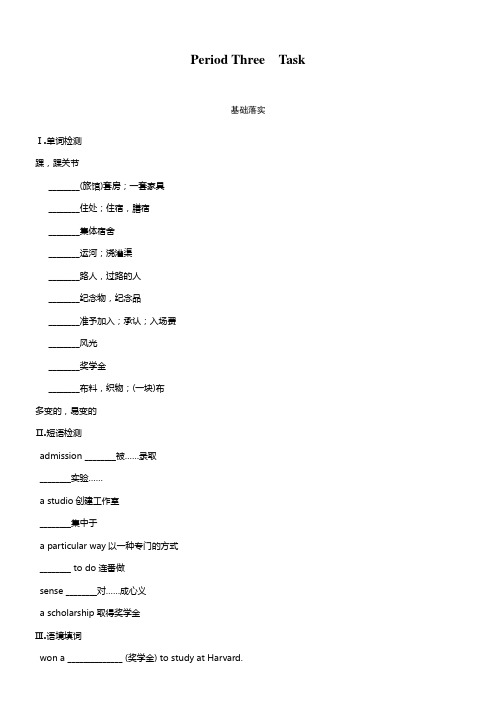
Period Three Task基础落实Ⅰ.单词检测踝,踝关节________(旅馆)套房;一套家具________住处;住宿,膳宿________集体宿舍________运河;浇灌渠________路人,过路的人________纪念物,纪念品________准予加入;承认;入场费________风光________奖学金________布料,织物;(一块)布多变的,易变的Ⅱ.短语检测admission ________被……录取________实验……a studio创建工作室________集中于a particular way以一种专门的方式________ to do连番做sense ________对……成心义a scholarship取得奖学金Ⅲ.语境填词won a ______________ (奖学金) to study at Harvard.____________ (实验) until we succeeded in mixing the right colour. ________________ (毕业),I continued to devote myself to research. stopped now and then to admire the ________ (风光).is the __________(高度) of the mountain?are many famous works of art on show in the ________(画廊).Ⅳ.单项填空admitted ________ a story to explain the reason why she was late.have made up toldhave told made uphis age,he did it quite well,so don’t ________ him any more.;scold ;say;speak ;blameplane is flying at the ________ of 10,000 meters in the sky.are ________ on the mixing of the oil and water.5.—To build up my business,and it almost killed me.—Well,you know what they .is no smoke without firemakes perfectroads lead to Romepains,no gainsyou need something,please don’t hesitate to let me know.casecase oftwo drivers could do nothing but________ the truck.take turns to drive turns to driveturns driving turns to driveas the clothes a person wears,the food he eats and the friends with whom he spends his time,his house________his personality.’s not what we do once in a while ________ shapes our lives,but we do consistently.coat is too large and,________,I don’t like its color too.additionⅤ.微写作写作素材1.上礼拜咱们去了展览馆。
- 1、下载文档前请自行甄别文档内容的完整性,平台不提供额外的编辑、内容补充、找答案等附加服务。
- 2、"仅部分预览"的文档,不可在线预览部分如存在完整性等问题,可反馈申请退款(可完整预览的文档不适用该条件!)。
- 3、如文档侵犯您的权益,请联系客服反馈,我们会尽快为您处理(人工客服工作时间:9:00-18:30)。
•heading— what the report is about •introduction— place of visit / date of visit /what was seen/ people met •description of what was seen •description of people met •conclusion— what you thought of the visit
Possible example
Student:Good morning, Mr Zhang. Could you spare me a few minutes to answer some questions? Artist:Sure, I’m very glad to. What would you like to know about? Student: I enjoy your masterpiece very much. It is fantastic, but I wonder where you got the idea from? Artist: … Student: What did you do first? Artist: … Student:What did you do next? Artist: …
The exhibition 1.The collection 1_2__p_a_in_t_i_n_g_s_, _p_r_in_t_e_d_b_e_t_w_e_e_n__2_0_0_3_a_n_d__2_0_0_4___ 2.The masterpiece: G__u_il_in__H__ei_g_h_t_s,_o_v_e_r__3_m__t_a_ll_, _fo_c_u_s_i_n_g_o_n__s_ev_e_r_a_l c_a_v_e_s_, _p_a_in_t_e_d__in__a_u_n__iq_u_e__w_a_y_
painted many scenes of the__c_a_n_a_ls_ in Suzhou
_w_a_s__a_d_m_i_t_te_d__t_o the Beijing School of Art Won a s_c_h_o_l_a_r_sh_i_pto study in the USA Painted Glance of Gu_i_l_in_______
Do some exercise to review.
Conclusion _fa_n_t_a_s_ti_c_a_n_d__i_m_p_r_e_s_s_iv_e_,_p_a_i_n_t_ed__a_t_d_i_f_fe_r_e_n_t____ _a_n_g_le_s_, _c_a_n_n_o_t_b_e__m_i_s_se_d_
Homework Preview the following part.
The artist: _b_o_rn__i_n_H__a_n_g_z_h_o_u__in__1_9_6_1_, _a_d_m_i_t_te_d__t_o_B_e_i_ji_n_g___ _S_ch__o_o_l _o_f_A_r_t_i_n_1_9_8_3_,_s_e_t_u_p__a_s_t_u_d_i_o_i_n_________ _H_a_n_g_z_h_o_u__a_ft_e_r_g_r_a_d_u_a_t_i_o_n_, _s_tu_d_i_e_d_i_n__th_e__U_S_A___ _in__th_e__1_9_9_0_s_, _p_r_es_e_n_t_e_d_h_i_s_p_a_i_n_t_in_g__in__G__u_il_in_____
Step 1 taking notes to report on a visit
Things to include in my report
1. what place I visited 2. _w_h_e_n_I went to there 3. _w_h_a_t_I went to see 4. _t_h_e_r_e_a_s_o_n_ for the trip
*describe some of the__p_a_in_t_i_n_g_s *say whether I_l_ik__ed_ them or not
5. give some details about the painter and his_l_if_e__ *where he_g_r_e_w__u_p *how he became_i_n_te_r_e_s_t_ed_ in painting *where he has_s_t_u_d_i_ed_
mb__eae_sn_t_ec_ar_lpl_ei_de_cae and
it is _3_metres tall
Skills building 2: asking technical questions
Useful expressions
Where did you get the idea from? What did you do first? What did you do next? How did you get this effect? How long did it take you to finish your work? How did you decide what to call it? What do you think of it?
Step 2: finding out technical information
Work in pairs According to P44, one student act as the artist and the other as the student who interviews the artist.
Because you are writing about something that has happened, you should use the past tense.
Possible example
Report on Art Club visit to _G_l_a_n_c_e_o_f__G_u_i_li_n_ Introduction P__la_c_e__o_f _v_is_i_t:_C__it_y_A__r_t_G__a_ll_e_y_ D__a_t_e_o_f_v_i_si_t_:_2_9_t_h_M__a_y_______ W __h__a_t _w_a_s_s_e_e_n_:_a_n__e_x_h_ib__it_io_n__b_y__zh__a_n_g_L__in_g_h_o_n_g_
Student:Thank you very much, Mr Zhang. This helps me a lot in understanding your art. Artist: Glad you enjoy it.
Skills building 3 : writing a report on a visit
the information included in the report on a visit:
• the place visited • when the visit took place • why the visit took place • what you saw on the visit • who you met on the visit • any other interesting information
works
•early works were _tr_a_d_i_t_io_n_a_l __C_h_i_n_e_s_e_s_t_y_le_ __w_a_t_e_r_c_o_lo_u_r_s_ that ________ the scenery of eastern Chinareflected •Glance of Guilin is a c_o_l_l_in__H_e_i_g_h_ts_ has
高中英语课件
madeofcanruohanxing
Unit 3 The world of colours and light
Task
Reporting on a visit to an art exhibition
Skills building 1: listening to instructions to report on a visit
about the artist and his work.
Artist Time 1961 D_u_r_in_g___ the 1970s
Zhang and 1980 L_i_n_g_h_ong
1983
1990s
between 2003 and 2004
Event b__o_rn__i_n_H__angzhou
6. Find out about his_m__a_st_e_r_p_i_ec_e_ 7. Find out why the painter chose the name for the exhibition.
22nd
29
5
20
Li River
hills
Read the brochure and get more information
